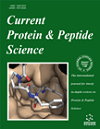- Home
- A-Z Publications
- Current Protein and Peptide Science
- Previous Issues
- Volume 17, Issue 5, 2016
Current Protein and Peptide Science - Volume 17, Issue 5, 2016
Volume 17, Issue 5, 2016
-
-
An Overview of Chromatin-Regulating Proteins in Cells
More LessAuthors: Pingyu Zhang, Keila Torres, Xiuping Liu, Chang-gong Liu and Raphael E. PollockIn eukaryotic cells, gene expressions on chromosome DNA are orchestrated by a dynamic chromosome structure state that is largely controlled by chromatin-regulating proteins, which regulate chromatin structures, release DNA from the nucleosome, and activate or suppress gene expression by modifying nucleosome histones or mobilizing DNA-histone structure. The two classes of chromatinregulating proteins are 1) enzymes Read More
-
-
-
Mutations of Chromatin Structure Regulating Genes in Human Malignancies
More LessAuthors: Jian Chen, Franklin H. Herlong, John R. Stroehlein and Lopa MishraChromatin structure regulating processes mediated by the adenosine triphosphate (ATP) – dependent chromatin remodeling complex and the covalent histone-modifying complexes are critical to gene transcriptional control and normal cellular processes, including cell stemness, differentiation, and proliferation. Gene mutations, structural abnormalities, and epigenetic modifications that lead to aberrant expressio Read More
-
-
-
The Functions of Histone Modification Enzymes in Cancer
More LessAuthors: Ruilin Wang, Mei Xin, Yanjiao Li, Pingyu Zhang and Meixia ZhangPosttranslational modifications of proteins critically regulate the function, localization, and stability of target proteins. Histone modification is one of the regulatory mechanisms that modulate the chromatin structure and thereby affect various DNA-templated processes, such as gene transcription, DNA replication, DNA recombination, and DNA repair in cells. These molecular processes contribute to basic cellular functi Read More
-
-
-
The Roles of Chromatin Remodeling Proteins in Cancer
More LessAuthors: Chun Zhang, Jie Lu and Pingyu ZhangChromatin remodeling complexes (chromatin remodelers) have been demonstrated as essential and powerful regulators for critical DNA-templated cellular processes, such as DNA replication, recombination, gene transcription/repression, and DNA damage repair. These molecular and genetic processes are important for a wide spectrum of cellular functions including, cell cycle, death, differentiation, pluripotency, and genome i Read More
-
-
-
Small Molecular Inhibitors Targeting Chromatin Regulating Proteins for Cancer
More LessAuthors: Jie Luan, Zhiyong Chu, Joya Chandra and Pingyu ZhangChromatin-regulating proteins modulate nucleosome structure by either modifying histones covalently or disrupting DNA-protein interaction directly with ATP hydrolysis. Evidence has shown that chromatin-regulating proteins play critical roles in regulation of molecular processes using DNA as template, including gene expression, DNA replication, DNA damage repair, and chromosome integrity. In most of human malignancies, c Read More
-
-
-
The Structure-Function Relationships of Complement Receptor Type 2 (CR2; CD21)
More LessHuman complement receptor type 2 (CR2; CD21) is a surface-associated glycoprotein which binds to a variety of endogenous ligands, including the complement component C3 fragments iC3b, C3dg and C3d, the low-affinity IgE receptor CD23, and the type I cytokine, interferon-alpha. CR2 links the innate complement-mediated immune response to pathogens and foreign antigens with the adaptive immune response by binding t Read More
-
-
-
The Melanocortin Receptor System: A Target for Multiple Degenerative Diseases
More LessAuthors: Minying Cai and Victor J. HrubyThe melanocortin receptor system consists of five closely related G-protein coupled receptors (MC1R, MC2R, MC3R, MC4R and MC5R). These receptors are involved in many of the key biological functions for multicellular animals, including human beings. The natural agonist ligands for these receptors are derived by processing of a primordial animal gene product, proopiomelanocortin (POMC). The ligand for the MC2R i Read More
-
-
-
Structure and Function of CW Domain Containing Proteins
More LessAuthors: Yanli Liu, Shasha Liu, Xinxin Zhang, Xiao Liang, Kashif Rafiq Zahid, Ke Liu, Jinlin Liu, Lingfu Deng, Jihong Yang and Chao QiThe CW domain is a zinc binding domain, composed of approximately 50- 60 amino acid residues with four conserved cysteine (C) and two to four conserved tryptophan (W) residues. The members of the superfamily of CW domain containing proteins, comprised of 12 different eukaryotic nuclear protein families, are extensively expressed in vertebrates, vertebrate-infecting parasites and higher plants, where they are ofte Read More
-
-
-
Occurrence, Functions and Biological Significance of Arginine-Rich Proteins
More LessAuthors: Thimmegowda Chandana and Yeldur P. VenkateshArginine, the most basic among the 20 amino acids, occurs less frequently than lysine in proteins despite being coded by six codons. Only a few important proteins of biological significance have been found to be abundant in arginine. It has been established that these arginine-rich proteins have been assigned important roles in the biological systems. Arginine-rich cationic proteins are known to stabilize macromolecular stru Read More
-
Volumes & issues
-
Volume 26 (2025)
-
Volume 25 (2024)
-
Volume 24 (2023)
-
Volume 23 (2022)
-
Volume 22 (2021)
-
Volume 21 (2020)
-
Volume 20 (2019)
-
Volume 19 (2018)
-
Volume 18 (2017)
-
Volume 17 (2016)
-
Volume 16 (2015)
-
Volume 15 (2014)
-
Volume 14 (2013)
-
Volume 13 (2012)
-
Volume 12 (2011)
-
Volume 11 (2010)
-
Volume 10 (2009)
-
Volume 9 (2008)
-
Volume 8 (2007)
-
Volume 7 (2006)
-
Volume 6 (2005)
-
Volume 5 (2004)
-
Volume 4 (2003)
-
Volume 3 (2002)
-
Volume 2 (2001)
-
Volume 1 (2000)
Most Read This Month
Article
content/journals/cpps
Journal
10
5
false
en


